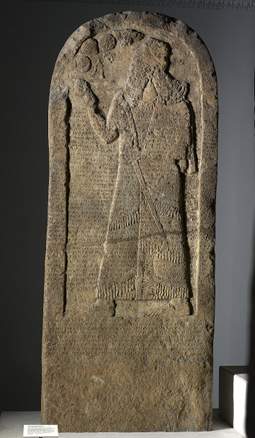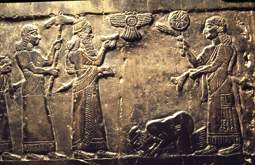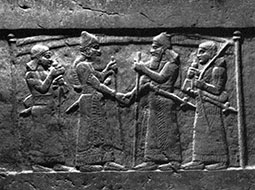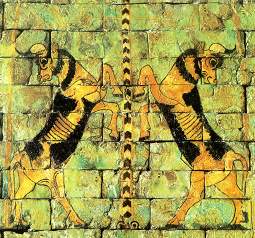Shalmaneser III, king of Assyria (r. 858-824 BC)
The task of building on Assurnasirpal II's impressive legacy fell to his son and successor, Shalmaneser III. He proved himself to be a highly capable ruler who significantly extended the borders of the Assyrian empire and made important contributions to the architecture of Assyria's new capital city, Kalhu.
To war!

Image 1: An inscribed stela TT of Shalmaneser III, known as the Kurkh Stela and standing approx. 2.2 metres tall. Inscribed over the image of the king is a narrative of his military achievements, including his campaigns against the Syrian coalition led by Ahunu PGP of Bit-Adini PGP . BM 118884. View large image on British Museum website. © The Trustees of the British Museum.
Shalmaneser acceded to the throne on the death of his father and predecessor, Assurnasirpal II. Cuneiform TT sources tell us nothing about his life or training before he became king, but he certainly threw himself into his new role with vigour. Shortly after his accession Shalmaneser set out on his first campaign, and these military exploits set the tone for the remainder of his reign. The king campaigned every year, sometimes more than once. Altogether, thirty-five campaigns are recorded in his inscriptions. They took him all over the Near East and far beyond the borders of Assyria.
Resistance in Syria
Much of Shalmaneser's campaigning took place in northern Syria, across the Euphrates river which represented the western boundary of the Assyrian empire at this time. This region was important because it allowed access to the trade-rich Mediterranean as well as to the prized cedar TT groves of Lebanon PGP . But it was also the centre of an anti-Assyrian coalition led by Ahunu PGP , the ruler of Bit-Adini PGP , a kingdom whose capital, Til-Barsip PGP , lay just east of the Euphrates PGP . Ahunu had been a vassal TT of Assurnasirpal II, but now saw the accession of a new and inexperienced king as an opportunity to regain his independence. He rallied a number of powerful states to his cause, including Sam'al PGP , Carchemish PGP and Que PGP . Shalmaneser defeated the coalition's troops in battle in 858 BC, but Ahunu continued to resist for three more years. His city Til-Barsip was captured by Shalmaneser, who renamed it Kar-Shalmaneser ("trading station/quay of Shalmaneser"). Ahunu himself fled across the Euphrates and took refuge in a mountain fortress, but in vain: he was pursued and defeated by Shalmaneser, who promptly deported him to Assyria.
Shalmaneser now turned his attention to southern Syria. In 853 BC he pillaged three cities belonging to Irhuleni PGP , king of Hamath, and torched his royal city Qarqar PGP on the Orontes PGP river. Shalmaneser was then confronted by yet another anti-Assyrian alliance. Led by Irhuleni and Adda-idri PGP , king of Damascus, and supported by twelve other rulers, its combined forces included 1,000 camels belonging to Gindibu'u the Arab PGP (from the Syrian desert) and 1,000 footsoldiers from Egypt PGP . Shalmaneser fought the coalition on several occasions before inflicting a decisive defeat in 845, although its leaders managed to escape with their lives. In 841 BC Shalmaneser was able to march against Damascus PGP (now ruled by a new king, Hazael PGP ) and defeat it.
Urartu: Assyria's arch-enemy emerges

Image 2: Detail from the Black Obelisk, showing Iaua (Biblical Jehu), king of Israel, in a gesture of submission before Shalmaneser III. BM 118885. View large image on British Museum website. © The Trustees of the British Museum.
Shalmaneser campaigned many times in the region of the upper Diyala PGP river and the Zagros PGP Mountains to the north of Assyria. His exploits there repeatedly brought him into conflict with the state of Urartu PGP . It was during this time that a new, powerful dynasty gradually claimed control over the region around and between Lakes Van PGP (in what is now eastern Turkey), Sevan PGP (in Armenia PGP ) and Urmia PGP (northwestern Iran). This development may have been prompted by a need to establish a united front against Assyria in direct response to Shalmaneser's military action in the area. Under the dynasty's leadership, Urartu emerged as a strong, politically unified state which would prove to be a formidable enemy to Assyria until its defeat by Sargon II PGP (r. 721-705 BC) in 714 BC.
Assyria's victory against the kingdom of Damascus prompted the submission of Tyre PGP and Sidon PGP , wealthy Phoenician PGP city-states, and of Israel PGP (the "house of Omri"). The submission of Iaua PGP , king of Israel, is depicted on Shalmaneser's famous Black Obelisk from Kalhu (Image 2). The king's earlier conquests were also commemorated in his royal city: the name of Irhuleni of Hamath was found inscribed on some shells (1), and Hazael's name accompanied the rich spoils of war brought from Damascus to Kalhu (2).
Shalmaneser recorded his campaigns in the north in inscriptions as well as in striking images on the bronze TT bands of the Balawat Gates, an ornamental door from Balawat PGP near Kalhu. The Balawat Gates also showed Shalmaneser's visit to the source of the river Tigris which was associated with the so-called Tigris Grotto PGP in the region of Šubria PGP (Image 3). The source was a symbolically important location for Assyrian kings, and Shalmaneser's celebrations are described in some detail in his inscriptions:

Image 3: Detail from the Balawat Gates, showing Shalmaneser's celebrations at the source of the Tigris river. BM 124656. View large image on British Museum website. © The Trustees of the British Museum.
I marched to the source of the Tigris, where the water comes out. I washed the weapon of Aššur PGP in it, made sacrifices to my gods, (and) put on a joyful banquet. I created my colossal royal statue (and) wrote thereon the praises of Aššur, my lord, (and) all my heroic deeds which I had accomplished in the lands. I erected it there (3).
Shalmaneser's expansion of Assyria's borders in the north and north-east prompted certain administrative reforms. These were designed to deal with the specific challenges of defending the newly-added territories from external threats. The king's solution was to entrust the new provinces TT to his most trusted military officials, chosen among the so-called magnates. In this way, he could ensure that the governors TT remained loyal and could be relied on to rally their troops quickly in the event of a conflict. The same practice was also adopted by Sargon II a century later.
Peace in Babylonia
Shalmaneser's reign saw Assyria enjoy a stable and peaceful relationship with her southern neighbour, Babylonia. This was partly the result of a peace treaty first concluded between the two nations by Shalmaneser's great-grandfather, Adad-nerari II PGP (r. 911-891 BC), and renewed in turn by Shalmaneser. Under the terms of the treaty, the Assyrian king was obliged to come to the aid of his Babylonian counterpart when summoned. Shalmaneser honoured this obligation when Marduk-zakir-šumi PGP , the king of Babylon, faced a rebellion led by his brother following their father's death. He led two campaigns against the rebellious brother and succeeded in reinstating Marduk-zakir-šumi on the throne. Assyria's successful intervention was later commemorated on the throne base at Fort Shalmaneser (Image 4).
Dayyan-Aššur, the king's right hand man

Image 4: Detail of the throne base from Fort Shalmaneser, showing Shalmaneser III (on the left) grasping the hand of Marduk-zakir-šumi PGP , king of Babylonia. The scene commemorates Shalmaneser's support of Marduk-zakir-šumi PGP against his rebellious brother, Marduk-bel-usati PGP (4). View large image. Photo: Iraq Museum.
Only towards the end of his reign, when he must have been an elderly man, did Shalmaneser delegate the role of commander-in-chief. Between 830 and 826 BC, military campaigns were led by his general (turtānu), Dayyan-Aššur PGP . Highly unusually, Dayyan-Aššur's role was even commemorated in Shalmaneser's annals, which gave credit to the general for his victories on the same extravagant terms normally reserved only for the Assyrian king:
I (i.e. Shalmaneser) issued orders (and) sent Dayyan-Aššur, the field marshal, chief of my extensive army, to lead my army to Urartu. He went down to Bit-Zamani, entered the pass of the city Ammaš, and crossed the river Arṣania. When Seduru, the Urartian, heard (of this), relying on the might of his mighty army he attacked to wage war and battle. He fought with him, defeated him (and) filled the wide plain with the corpses of his warriors (5).
Shalmaneser's general was also given the great honour of being chosen as the year's eponym official TT for 826 BC. Dayyan-Aššur's prominent role in the inscriptions is very unconventional. However, the royal annals were merely repeating the text of the Black Obelisk, a monument which celebrates the joint achievements of Shalmaneser III and his general. Since it is likely that the Black Obelisk was commissioned by Dayyan-Aššur himself rather than by the king, this would help explain Dayyan-Aššur's unprecedented visibility (6).
Royal women
Royal inscriptions and other textual sources record Shalmaneser's place in the male line of the Assyrian ruling dynasty, but such sources rarely tell us anything about the women of the royal family. However, excavations underneath the women's quarters of the Northwest Palace have uncovered four tombs in which royal women were buried.
Tomb III, found in 1989, contained a sarcophagus TT with an inscribed lid which identified it as:
belonging to Mullissu-mukannišat-Ninua PGP , queen TT of Assurnasirpal (II), king of Assyria, and Shalmaneser (III), king of Assyria... Daughter of Aššur-nirka-daʾʾini PGP , chief cup-bearer of Assurnasirpal, king of Assyria (7).
But if Mullissu-mukannišat-Ninua's relationship to Assurnasirpal is clear, her connection to Shalmaneser is a little more ambiguous. Did Shalmaneser marry his father's widow? Or was Mullissu-mukannišat-Ninua his mother, playing the role of queen mother after her son's accession? There is nothing to suggest that marrying a predecessor's widow was common practice in Assyria, and the second possibility therefore seems more likely.
Although little is known about Mullissu-mukannišat-Ninua's role as queen mother, it anticipated other prominent royal women of the 9th and 8th centuries. Sammu-ramat PGP , the wife of Shalmaneser's son, Šamši-Adad V PGP (r. 823-811 BC), and Naqiʾa/Zakutu PGP , the mother of Esarhaddon PGP (r. 681-669 BC), both wielded considerable political power. Sammu-ramat, who was the historical inspiration behind the legendary Semiramis PGP , even joined the Assyrian army on campaign (8) and had a stela TT inscribed in her name and displayed in Assur PGP (9).
Building work at Kalhu and elsewhere

Image 5: Detail of a glazed TT brick panel from Shalmaneser III's palace at Kalhu, now known as Fort Shalmaneser. The 4 metre-high panel decorated the entrance to a large room next to the palace's throne room. It is now in the Iraq Museum TT , Baghdad. © Virtual Museum of Iraq.
Shalmaneser carried out significant building projects in central Assyria. In Assur, the religious capital of the state, he carried out important repairs to the city walls as well as a number of temples, including that of the god Aššur himself. He also carried out building work on Nineveh's temple of the goddess Ištar PGP . The king was particularly active in Kalhu, where he continued the work begun by his father. His most visible contribution to the city's architecture included the ziggurat of the Ninurta temple, a structure which still dominates the Nimrud skyline today. He was also responsible for commissioning Fort Shalmaneser, a richly decorated and furnished palace complex (Image 5).
Rebellion
The final years of Shalmaneser's long and successful reign were marred by serious internal conflict. In 826 BC, after more than thirty years on the throne, a rebellion broke out in Assyria. Details of the revolt are sketchy, but it seems that it was motivated by a struggle for the succession TT , and was initiated by a son of Shalmaneser, Aššur-daʾʾin-aplu PGP (10). The uprising eventually spread to twenty-seven cities, including the major urban centres in the heart of Assyria: Nineveh PGP , Assur PGP , Arbela PGP and Arrapha PGP . Shalmaneser III died two years later in unknown circumstances, and it was left to another son and his successor, Šamši-Adad V, to quash the rebellion for good and re-establish control over Assyria. That this was no easy task is shown by the Eponym Chronicle according to which the revolt lasted four years into Šamši-Adad's reign.
Content last modified: 18 Dec 2019.
References
- Oates, D. and J. Oates, 2001. Nimrud, An Assyrian Imperial City Revealed, London: British School of Archaeology in Iraq ( free PDF from BISI, 128 MB), pp. 17, Fig. 6. (Find in text ^)
- Oates, D. and J. Oates, 2001. Nimrud, An Assyrian Imperial City Revealed, London: British School of Archaeology in Iraq ( free PDF from BISI, 128 MB), p. 181. (Find in text ^)
- Grayson, A.K., 1996. Assyrian Rulers of the Early First Millennium BC II (858-745 BC) (Royal Inscriptions of Mesopotamia. Assyrian Periods. Volume 3), Toronto: University of Toronto Press, pp. 65-66, A.0.102.14:69-72. (Find in text ^)
- Oates, D. and J. Oates, 2001. Nimrud, An Assyrian Imperial City Revealed, London: British School of Archaeology in Iraq ( free PDF from BISI, 128 MB), pp. 176, Fig. 110. (Find in text ^)
- Grayson, A.K., 1996. Assyrian Rulers of the Early First Millennium BC II (858-745 BC) (Royal Inscriptions of Mesopotamia. Assyrian Periods. Volume 3), Toronto: University of Toronto Press, pp. 69, A.0.102.14:141-146. (Find in text ^)
- Yamada, S., 2000. The Construction of the Assyrian Empire: A Historical Study of the Inscriptions of Shalmaneser III (859-824 BC) Relating to His Campaigns in the West, Leiden: Brill, pp. 332-334. (Find in text ^)
- Oates, D. and J. Oates, 2001. Nimrud, An Assyrian Imperial City Revealed, London: British School of Archaeology in Iraq ( free PDF from BISI, 128 MB), p. 85. (Find in text ^)
- Grayson, A.K., 1996. Assyrian Rulers of the Early First Millennium BC II (858-745 BC) (Royal Inscriptions of Mesopotamia. Assyrian Periods. Volume 3), Toronto: University of Toronto Press, pp. 204-205, A.0.104.3. (Find in text ^)
- Grayson, A.K., 1996. Assyrian Rulers of the Early First Millennium BC II (858-745 BC) (Royal Inscriptions of Mesopotamia. Assyrian Periods. Volume 3), Toronto: University of Toronto Press, pp. 226, A.0.104.2001. (Find in text ^)
- Grayson, A.K., 1996. Assyrian Rulers of the Early First Millennium BC II (858-745 BC) (Royal Inscriptions of Mesopotamia. Assyrian Periods. Volume 3), Toronto: University of Toronto Press, pp. 183, A.0.103.1. (Find in text ^)
Further reading
- Baker, H.D. and Yamada, S., 2002. "Salmānu-ašarēd", in H.D. Baker (ed.),The Prosopography of the Neo-Assyrian Empire, Volume 3, Part I: P-Ṣ, Helsinki: Helsinki University Press, pp. 1071-1078.
- Baker, H.D., 2006-08. "Salmanassar III.", Reallexikon der Assyriologie und Vorderasiatischen Archäologie 11, pp. 581-585.
- Grayson, A.K., 1996. Assyrian Rulers of the Early First Millennium BC II (858-745 BC) (Royal Inscriptions of Mesopotamia. Assyrian Periods. Volume 3), Toronto: University of Toronto Press.
- Oates, D. and J. Oates, 2001. Nimrud, An Assyrian Imperial City Revealed, London: British School of Archaeology in Iraq ( free PDF from BISI, 128 MB).
- Yamada, S., 2000. The Construction of the Assyrian Empire: A Historical Study of the Inscriptions of Shalmaneser III (859-824 BC) Relating to His Campaigns in the West, Leiden: Brill.
Silvie Zamazalová
Silvie Zamazalová, 'Shalmaneser III, king of Assyria (r. 858-824 BC)', Nimrud: Materialities of Assyrian Knowledge Production, The Nimrud Project at Oracc.org, 2019 [http://oracc.museum.upenn.edu/nimrud/ancientkalhu/thepeople/shalmaneseriii/]